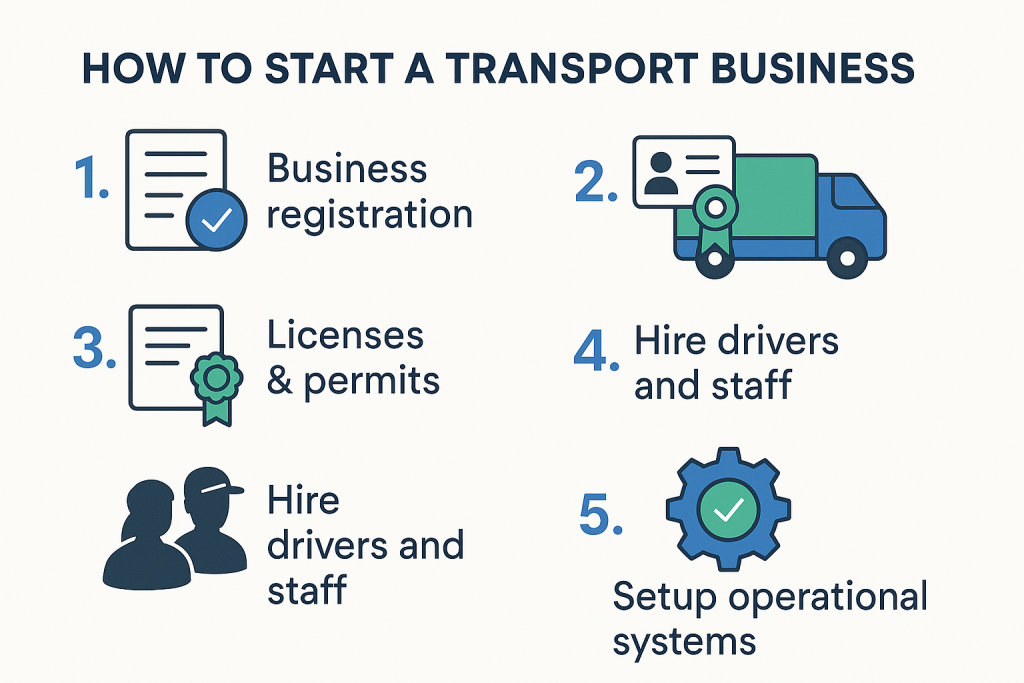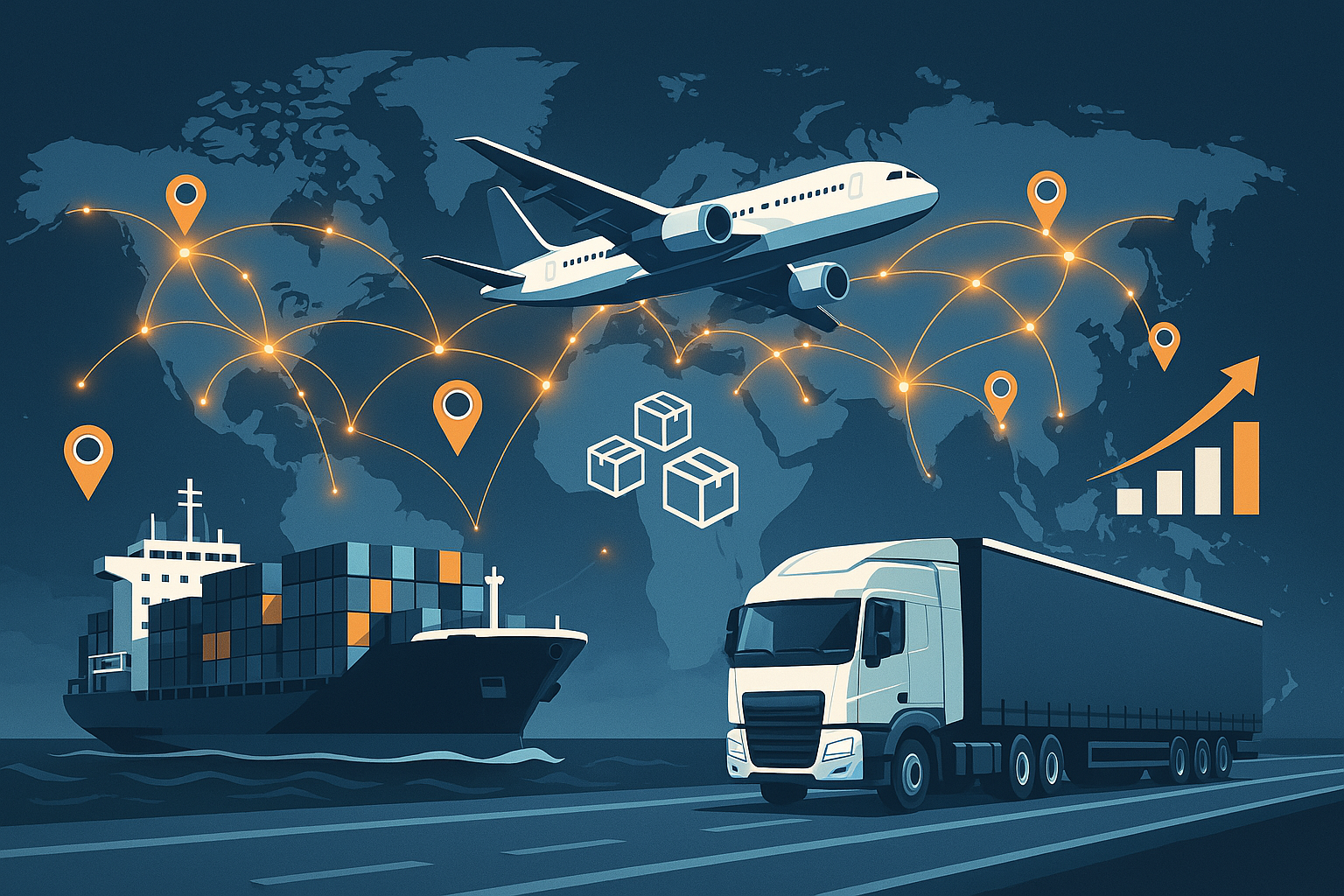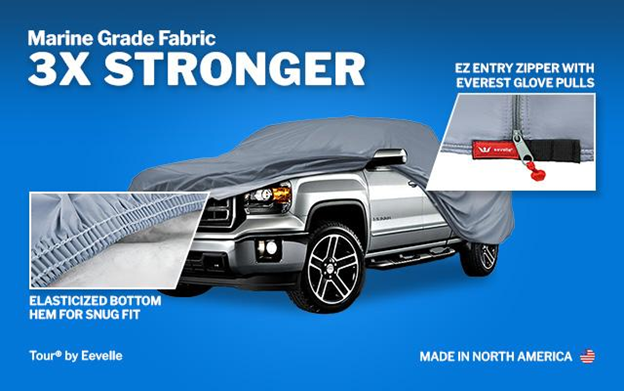Starting a transport business can be an exciting and profitable venture. As global trade grows and consumer demand for delivery services rises, the need for efficient and reliable transport solutions continues to expand. Whether you’re considering logistics, freight transport, or passenger services, there is immense potential for success in this industry — if you lay the right foundation.
In this comprehensive guide, we’ll walk you through everything you need to know to start a transport business from scratch and scale it sustainably. From understanding the market landscape to growing your fleet and keeping your customers happy, you’ll find actionable insights at every step.
Table of contents
- Understanding the Transport Industry Landscape
- Market Trends and Growth Opportunities
- Identifying Gaps and Niche Markets
- Step-by-Step Guide to Starting Your Transport Business
- Strategies to Scale and Grow Your Transport Business
- Marketing and Customer Retention in the Transport Industry
- Final Thoughts
- FAQ: Starting and Growing a Transport Business
- 1. What are the initial costs to start a transport business?
- 2. How do I get clients for my transport business?
- 3. What are the legal requirements to start a transport company?
- 4. How can I scale my transport business sustainably?
- 5. What challenges do transport businesses commonly face?
- 6. What types of insurance are necessary for a transport business?
- 7. Should I buy or lease vehicles for my transport business?
- 8. How do I handle vehicle maintenance and repairs?
- 9. What technology can help manage my transport business effectively?
- 10. How can I make my transport business eco-friendly?
Understanding the Transport Industry Landscape
The transport sector is undeniably the backbone of global economies, enabling commerce, connecting communities, and driving development. From moving raw materials to factories, finished goods to retailers, and people across cities and countries, transport plays a crucial role in ensuring the smooth operation of supply chains and daily life.
This vast industry spans several major segments:
- Freight transport: Involves the bulk movement of goods via road, rail, air, or sea.
- Logistics services: Includes warehousing, inventory management, and the coordination of complex supply chains.
- Courier and parcel delivery: Focused on smaller shipments, this segment has exploded with the growth of e-commerce.
- Passenger transportation: From ride-sharing services to long-distance bus travel and private shuttles, moving people efficiently remains a cornerstone of the industry.
With businesses and consumers alike demanding faster, more reliable, and sustainable transportation solutions, the sector continues to evolve rapidly. Whether it’s urban commuters or multinational corporations, everyone relies on transport services in some way — making it a fertile ground for entrepreneurs looking to establish a foothold.
Market Trends and Growth Opportunities
The transport industry is experiencing unprecedented growth, largely driven by powerful global forces. Understanding these trends is essential for anyone looking to start or scale a transport business.
E-commerce Boom
The surge in online shopping has dramatically increased the demand for reliable delivery services. Giants like Amazon and Shopify have redefined consumer expectations — what was once considered fast delivery (3–5 days) is now too slow. Consumers want next-day or even same-day shipping, which places enormous pressure on transport providers to optimize routes, manage inventory, and deliver on time.
Global Trade Expansion
Trade liberalization and advancements in global logistics have made it easier for businesses to source materials and sell products worldwide. This opens up opportunities for transport companies to offer cross-border services, freight forwarding, and customs clearance assistance.
Rise of Last-Mile Delivery
As cities expand, the final leg of delivery — known as last-mile delivery — has become one of the most critical and complex aspects of logistics. Companies that can efficiently navigate urban congestion and customer expectations will thrive.
Technological Advancements
Automation, artificial intelligence, and Internet of Things (IoT) devices are transforming transport operations. Real-time tracking, predictive maintenance, automated dispatching, and data analytics help companies improve efficiency and customer satisfaction.
Sustainability and Green Logistics
Governments and businesses alike are placing a growing emphasis on reducing carbon footprints. Eco-friendly transport solutions such as electric vehicles, alternative fuels, and carbon offsetting services are not only desirable but may soon become mandatory in some markets.
In short, whether you’re focusing locally or globally, the market offers plenty of opportunities — especially for businesses willing to embrace innovation and sustainability.
Identifying Gaps and Niche Markets
While the transport industry offers plenty of opportunities, competition is fierce. The key to standing out lies in identifying underserved niches and tailoring your services to meet specific customer needs.
Specialized Transport Services
Certain sectors require specialized transportation, such as:
- Refrigerated transport for perishable goods like dairy, meat, or pharmaceuticals.
- Hazardous materials transport with specific safety protocols and certifications.
- Luxury vehicle transport for high-value cars and machinery.
If your local market lacks providers for these services, you could quickly become the preferred choice.
Serving Underserved Regions
Rural areas and less-developed markets often struggle with limited transport options. Building routes into these regions not only opens up new revenue streams but can also position your business as a community-oriented, essential service provider.
Eco-Conscious Consumer Base
With sustainability gaining prominence, businesses that adopt eco-friendly practices can attract environmentally conscious customers. Offering electric vehicle deliveries, carbon-neutral shipping, or partnering with green suppliers could be your unique selling point.
B2B Solutions for SMEs
Small and medium enterprises (SMEs) often get overlooked by large transport providers focused on big contracts. By offering flexible, affordable, and personalized logistics solutions to SMEs, you can build loyal partnerships and tap into a highly lucrative client base.
On-Demand and Custom Services
Today’s consumers crave convenience. Offering on-demand transport services, such as same-day courier pickups or customizable delivery windows, can set your business apart from competitors who follow rigid schedules.
Data-Driven Decision Making
Utilize market research tools, customer surveys, and industry reports to identify gaps where customer needs aren’t being fully met. Social media listening and Google Trends can also provide valuable insights into emerging demands and underserved markets.
By focusing on a specific niche and becoming an expert in that space, you not only reduce direct competition but also create a loyal customer base that values your tailored solutions. This strategy is especially powerful when scaling your business, as specialized services often command higher profit margins and customer loyalty.

Step-by-Step Guide to Starting Your Transport Business
Building a transport company is much more than just owning a few vehicles. It requires careful planning, compliance with regulations, and an efficient operational system to deliver consistent, reliable service.
Legal Requirements: Licenses, Permits, and Insurance
The first step is to make your business legal. Transport businesses must comply with both national and local regulations. These typically include:
- Business registration: Register your business name and structure (LLC, corporation, sole proprietorship).
- Operating license: Depending on your country or state, this may include commercial vehicle operator registration.
- Commercial driver’s licenses (CDL): If you plan to drive or employ drivers, ensure they have the proper licensing.
- Insurance: Commercial vehicle insurance, liability insurance, and cargo insurance are critical for protecting your business.
- Permits: Cross-state or international transport may require additional permits.
Researching these requirements thoroughly before starting will save you from costly fines and legal issues later.
Building Your Fleet
Your fleet is the heartbeat of your operation. When choosing between buying or leasing vehicles, consider your budget, maintenance capabilities, and long-term goals.
- Buying: High upfront cost but long-term asset ownership.
- Leasing: Lower upfront costs, but you’ll pay recurring fees.
Ensure your vehicles meet regulatory standards, especially if you’re handling specialty goods like food, chemicals, or live animals. Don’t forget to factor in fuel efficiency and maintenance costs for optimal profitability.
Hiring Drivers and Support Staff
Your team will represent your brand every day. Hire experienced, qualified drivers and provide ongoing training to ensure safety and professionalism.
Roles to consider:
- Drivers: CDL-certified, with a clean driving record.
- Dispatchers: To manage routes and driver communication.
- Mechanics: For in-house maintenance (optional for larger fleets).
- Customer service staff: To handle bookings and inquiries.
Implement strict safety protocols and ensure compliance with labor laws and working hours regulations to keep your team safe and operations smooth.
Setting Up Operational Systems
Technology can streamline your operations significantly. Use fleet management software for:
- Route optimization: Save fuel and time.
- Real-time tracking: Keep customers informed and improve accountability.
- Maintenance scheduling: Prevent breakdowns and extend vehicle lifespan.
- Automated billing and invoicing: Reduce administrative workload.
By digitizing your processes early, you’ll create a scalable and efficient system.

Strategies to Scale and Grow Your Transport Business
Once your business is operational, the next step is growth. Scaling a transport business requires strategic planning and smart investments.
Leveraging Technology
Investing in modern technology enhances operational efficiency and customer satisfaction.
- GPS tracking systems allow real-time monitoring.
- Fleet management software automates dispatching and maintenance reminders.
- Customer portals provide clients with shipment updates, increasing transparency.
By adopting these tools, you’ll improve service quality and build trust with your customers.
Building Strong B2B Partnerships
Partnerships are the lifeblood of a successful transport business. Connect with manufacturers, wholesalers, retailers, and e-commerce businesses.
Offer them reliable service, competitive pricing, and tailored solutions. Attend industry trade shows and networking events to expand your reach. Referral incentives and loyalty programs can also keep clients coming back.
Expanding Service Offerings
Once you’ve stabilized your core services, consider diversifying to increase revenue streams. Options include:
- Regional expansion: Extend your service area to capture new markets.
- Specialized services: Refrigerated transport, hazardous material handling, or oversized cargo.
- International logistics: Partner with freight forwarders for global operations.
Always research demand and regulations before expanding.
Sustainable Growth Strategies
Sustainability isn’t just good for the planet — it’s great for business. Eco-friendly initiatives can reduce costs and appeal to environmentally conscious clients.
Implement:
- Fuel-efficient driving practices: Train drivers to minimize fuel use.
- Eco-friendly vehicles: Consider hybrids or electric trucks.
- Route planning: Reduce idle time and optimize delivery paths.
Some clients, especially large corporations, prefer working with green transport providers to meet their own sustainability goals.
Marketing and Customer Retention in the Transport Industry
No matter how efficient your operation is, you need customers to thrive. Effective marketing and stellar customer service will keep your fleet busy.
Building an Online Presence
Start with a professional website that showcases your services, fleet capabilities, and contact information. Integrate:
- Local SEO: Optimize your site for “transport services near me” and similar search terms.
- Google My Business: Ensure your business appears in local search results.
- Social media platforms: Share customer testimonials, behind-the-scenes looks at your operations, and industry news.
Consistent online visibility helps you attract new clients and build credibility.
Customer Service Excellence
In the transport business, reliability is everything. Make it easy for clients to reach you, provide real-time updates, and follow up after deliveries for feedback.
Consider implementing:
- 24/7 customer support for time-sensitive deliveries.
- Automated notifications for delivery updates.
- Customer loyalty programs to reward repeat business.
Satisfied customers will become your best marketers through word-of-mouth referrals.
Effective Pricing Strategies
Price your services competitively but sustainably. Avoid the race to the bottom by highlighting the value you provide — such as reliability, speed, and excellent customer support.
Offer:
- Volume discounts for regular clients.
- Flexible payment options to accommodate business cash flows.
- Promotional campaigns during off-peak seasons to maintain steady bookings.
Building Brand Reputation
In the transport industry, trust is your currency. Maintain your reputation by:
- Delivering on time, every time.
- Being transparent about delays or issues.
- Showcasing customer reviews and testimonials.
Reputation management is an ongoing effort, but it pays dividends in long-term business growth.
Final Thoughts
Starting a transport business offers vast opportunities, especially as global demand for reliable delivery and logistics services continues to rise. By understanding your market, investing in the right technology, prioritizing customer satisfaction, and growing sustainably, you can build a thriving transport company that stands the test of time.
Remember, success in this industry is a marathon, not a sprint. Stay focused, adapt to market trends, and keep moving forward — one mile at a time.
FAQ: Starting and Growing a Transport Business
1. What are the initial costs to start a transport business?
The startup costs vary depending on the scale. At a minimum, you’ll need to invest in vehicles, insurance, licenses, and technology systems. Don’t forget to budget for staff salaries, fuel, maintenance, and marketing expenses.
2. How do I get clients for my transport business?
Start by building a strong online presence and networking within your community. Attend industry events, partner with local businesses, and use targeted ads. Referrals from satisfied clients can also be powerful.
3. What are the legal requirements to start a transport company?
You must register your business, secure commercial insurance, obtain necessary permits, and ensure your drivers are properly licensed. Regulations differ by region, so consult local authorities to stay compliant.
4. How can I scale my transport business sustainably?
Use fleet management software, invest in fuel-efficient vehicles, and build strong relationships with clients. Sustainable scaling involves balancing growth with maintaining high service quality.
5. What challenges do transport businesses commonly face?
Common challenges include rising fuel costs, vehicle maintenance, driver shortages, and intense competition. Staying adaptable and focusing on operational efficiency can help mitigate these issues.
6. What types of insurance are necessary for a transport business?
You will typically need commercial vehicle insurance, general liability insurance, cargo insurance (especially for freight), and workers’ compensation if you have employees. Insurance protects your assets and helps ensure regulatory compliance.
7. Should I buy or lease vehicles for my transport business?
It depends on your budget and growth plan. Buying vehicles provides long-term ownership and equity, while leasing offers lower upfront costs and flexibility for scaling. Evaluate your financial situation and future goals before deciding.
8. How do I handle vehicle maintenance and repairs?
Set up a regular maintenance schedule to prevent costly breakdowns. Consider hiring in-house mechanics if you have a larger fleet, or partner with trusted service providers. Proactive maintenance extends the lifespan of your vehicles and keeps operations running smoothly.
9. What technology can help manage my transport business effectively?
Invest in fleet management software, GPS tracking systems, and automated billing tools. These technologies improve route efficiency, enhance customer service, and provide real-time insights into vehicle performance and delivery status.
10. How can I make my transport business eco-friendly?
Adopt fuel-efficient driving practices, invest in hybrid or electric vehicles, and optimize delivery routes to reduce emissions. Some clients specifically seek eco-conscious transport providers, making this a competitive advantage.




3 thoughts on “How to Start a Transport Business and Scale It for Success”
I don’t think the title of your article matches the content lol. Just kidding, mainly because I had some doubts after reading the article. https://accounts.binance.com/el/register?ref=IQY5TET4
Can you be more specific about the content of your article? After reading it, I still have some doubts. Hope you can help me.
I don’t think the title of your article matches the content lol. Just kidding, mainly because I had some doubts after reading the article. https://www.binance.com/bn/join?ref=P9L9FQKY